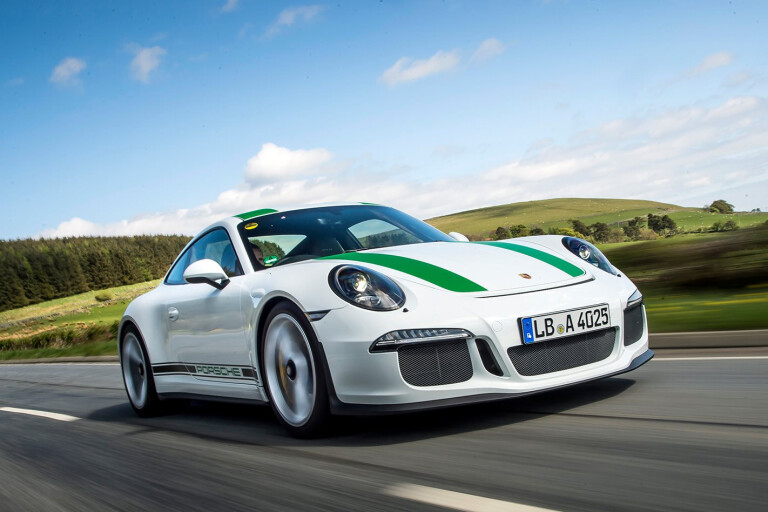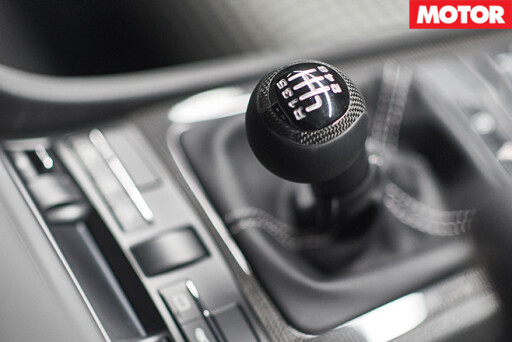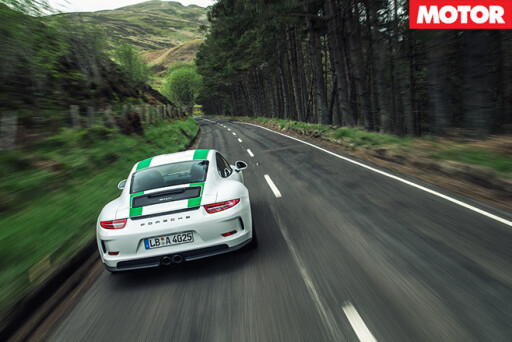
The north west of Scotland. There may be other places in the world as well-designed to showcase the talents of the new Porsche 911 R, but not many and certainly none in the United Kingdom.
Almost unbelievably, I have the car to myself. There’s no colleague next to me, stabbing at an imaginary brake pedal and thinking only of what might be the earliest viable opportunity to suggest now it is his turn to drive.
I am utterly alone in one of this kingdom’s few remaining true wildernesses equipped only with what, on-paper at least, appears to be the car of my dreams. There’s no route that’s been carefully configured to play to the car’s strengths; I can go where I like, how I like and, within reason, for as long as I like.
 The bare facts of the 911 R are almost certainly already known to you. I expect that if prizes were awarded for media coverage earned by a derivative of a derivative of an already very well known machine, the 911 R would sweep the board, so we’ll not dwell long on them here.
The bare facts of the 911 R are almost certainly already known to you. I expect that if prizes were awarded for media coverage earned by a derivative of a derivative of an already very well known machine, the 911 R would sweep the board, so we’ll not dwell long on them here.
But the machine now at my disposal is essentially a 911 GT3 RS complete with its 368kW/460Nm 4.0-litre engine and all the lightweight bits such as its magnesium roof and carbon wings and bumpers, but shorn of its downforce-generating bodywork and wings. Because it is no longer capable of adding hundreds of kilos to its own weight at speed, it doesn’t need super stiff ride-robbing spring rates to support the body under forces it will never experience.
Most important, there is a new six-speed manual gearbox, developed from the seven-speeder available on normal 911s but with bespoke ratios and a completely different action. Other changes we’ll get to as and when, but for now let’s take a closer look at what’s in front of us.
 I think the car looks incredible in white paint with green stripes, but I’m aware of the act it is trying to follow. I’ve driven an original 1967 911 R, to this day the lightest 911 ever created and a machine with a focus I’ve rarely encountered since.
I think the car looks incredible in white paint with green stripes, but I’m aware of the act it is trying to follow. I’ve driven an original 1967 911 R, to this day the lightest 911 ever created and a machine with a focus I’ve rarely encountered since.
But while today’s 911 R is neither as powerful relative to other 911s today as was the first 911 R back then, nor quite so insanely obsessive about weight saving at any cost (it at least has sun visors), the back to basics approach is the same. Then as now, the 911 R is the lightest 911 on sale.
The cabin is even better than the exterior. I’m sure Porsche didn’t intend the great holes in the centre console where the nav screen and its associated switches and controllers would live to seem so exciting – but they are. They speak to me of the car’s potential, and its designers’ no compromise attitude to saving weight.
 The same is true of the absent rear seats, the absent proper door handles and the absent air conditioning of any kind. But it’s really that little map on top of the gear lever that does it: not only does it prove this car is manual, but that its engineers were so focussed on the brief they totally re-engineered the transmission and dropped the seventh gear, thereby saving a bag of sugar of weight or, if you want it precisely, a single kilogram.
The same is true of the absent rear seats, the absent proper door handles and the absent air conditioning of any kind. But it’s really that little map on top of the gear lever that does it: not only does it prove this car is manual, but that its engineers were so focussed on the brief they totally re-engineered the transmission and dropped the seventh gear, thereby saving a bag of sugar of weight or, if you want it precisely, a single kilogram.
The seats have leather sides but tartan cloth inserts and remind me faintly of those in my Mk1 VW Golf GTi, which is an entirely good thing. This actual car is used for signing-off right hand drive production, so when you look at its little lightweight plaque you see it is numbered 000/991.
It can never be sold and the fate of most such cars is a one way journey to the crusher, but I hope and trust this one is spared and sent to the museum or earns a quiet retirement elsewhere in the Porsche empire.
 Having known this moment was likely for a while, I’d struggled with both sleep and breakfast. I’m blessed to drive plenty of fast cars, some with much more power than this, but when the prospect is the purest, simplest high performance 911 Weissach can make, I find myself transported back a quarter of a century to my days as a junior road tester when a night spent staring at the ceiling was an unavoidable precursor to a drive in any Porsche.
Having known this moment was likely for a while, I’d struggled with both sleep and breakfast. I’m blessed to drive plenty of fast cars, some with much more power than this, but when the prospect is the purest, simplest high performance 911 Weissach can make, I find myself transported back a quarter of a century to my days as a junior road tester when a night spent staring at the ceiling was an unavoidable precursor to a drive in any Porsche.
Why? Because the R offers the tantalising prospect of showing even 911 drivers something new, reaching a level of pure driving pleasure she or he may have until that very moment not realised existed.
For that is what it was designed to do: it’s not an all purpose weapon like a GT3, or a track-honed warrior like the RS – its one and only reason for being is to put a smile on the face of those with both the means, motive and opportunity to drive it the way its makers intended.
 And for the next couple of hours at least, I have all three. I also have a GT3 RS on standby, just for benchmarking purposes. If you are starting to think this entire story a work of fiction, a Porsche-shaped fantasy from the addled mind of a clearly delusional author enjoying the hallucinogenic properties of some quite clearly non-prescription drugs, I don’t blame you at all. In fact if I didn’t have the photographs to prove it really did happen, I’d probably agree with you.
And for the next couple of hours at least, I have all three. I also have a GT3 RS on standby, just for benchmarking purposes. If you are starting to think this entire story a work of fiction, a Porsche-shaped fantasy from the addled mind of a clearly delusional author enjoying the hallucinogenic properties of some quite clearly non-prescription drugs, I don’t blame you at all. In fact if I didn’t have the photographs to prove it really did happen, I’d probably agree with you.
Differences to the GT3 RS, other than the visual, are apparent before you’re even out of the car park. The steering is lighter, the ride more pliant. On the suspension side the 911 R has standard GT3 spring rates (which makes them effectively stiffer because they have less mass to control), bespoke damper settings and a rear tyre 305mm wide, some 20mm less than that of the GT3 RS. Porsche has also retuned the rear wheel steering system to suit the R’s unique dynamic requirements and remapped the electric power steering as well.
It’s meant to be noisier than the GT3 RS. I thought Porsche had already pulled out all the sound deadening for the RS, but it found more some that could be deleted for the R. If there is extra noise, it is when the engine is at full-chat, at which point you usually have other more pressing issues on your mind.
 The gearbox is a joy. It retains the first four ratios of the GT3 transmission, has an elongated fifth and sixth but, of course, not the seventh you find in the PDK ’box. I calculated that in sixth the car gains around 40km/h for every additional 1000rpm on the clock, which means it will be easing its way past 8000rpm as it tops out at 324km/h.
The gearbox is a joy. It retains the first four ratios of the GT3 transmission, has an elongated fifth and sixth but, of course, not the seventh you find in the PDK ’box. I calculated that in sixth the car gains around 40km/h for every additional 1000rpm on the clock, which means it will be easing its way past 8000rpm as it tops out at 324km/h.
Surprised it’s that fast when the GT3 RS will only reach a piffling 311km/h? It’s all in the wings, or lack thereof. The lever slips around the ’box with a weighty, mechanical precision and instantly you feel more connected to the car because, very literally, you are.
The road is open and deserted. If you select Sport mode it will perfectly rev-match your down changes, but I prefer to do that myself. Drop a ratio with a hopefully well-aimed stab of the right foot, hear the revs climb to meet the lower gear, nail the throttle and wait for the reaction. It doesn’t take long to arrive.
 You expect the acceleration, but not the feel of the car. While a GT3 RS hunkers down on the road ever more as speed rises and its wings work, bolting it to the surface, the 911 R feels en pointe by comparison. It seems lighter, more dainty and, while this would never be reflected in the lap time, more nimble.
You expect the acceleration, but not the feel of the car. While a GT3 RS hunkers down on the road ever more as speed rises and its wings work, bolting it to the surface, the 911 R feels en pointe by comparison. It seems lighter, more dainty and, while this would never be reflected in the lap time, more nimble.
We’re travelling quite quickly now. While the RS follows the contours of the road like a bloodhound’s nose follows a scent, the R allows itself the luxury of some space. There’s enough compliance in its springing to let the body breathe with the road, allowing just a little vertical movement. It’s never enough to be classified as float, but more than sufficient to absorb the lumps and bumps that would be felt by the RS driver and might even unsettle the car a little. Out here in the middle of nowhere, you need a little compliance and the R has it.
It helps you feel what the car is doing too, because the body’s movements and consequent weight transference make their presence felt through the steering and chassis. You can tell when the nose is running short of grip because the steering tangibly lightens, naturally encouraging you add the requisite corrective lock. But really, it’s the flood of data coming through the suspension and tyres and seat to your backside that makes you feel so deliciously at one with this machine.
 You try to find the flaws, of course you do, it’s your job. So, it doesn’t feel as ridiculously agile as an old 997 GT3 RS because good though the four-wheel steering is, it cannot entirely mitigate the stabilising effects of the 991’s far longer wheelbase. Some more hardcore drivers might also complain that it’s a little too easy, there’s insufficient challenge here because, baldly speaking, the car is just too bloody good. It’s not a view I support.
You try to find the flaws, of course you do, it’s your job. So, it doesn’t feel as ridiculously agile as an old 997 GT3 RS because good though the four-wheel steering is, it cannot entirely mitigate the stabilising effects of the 991’s far longer wheelbase. Some more hardcore drivers might also complain that it’s a little too easy, there’s insufficient challenge here because, baldly speaking, the car is just too bloody good. It’s not a view I support.
Even with its narrow tyres relative to the GT3 RS, its largely absent wings and street-specification suspension, this is a massively rapid cross country machine. If you drove 100 random people at the point-to-point speed this car will manage quite safely and comfortably, at least 99 of them and probably all 100 would simply not believe it possible.
The idea then of pushing this car so far and fast in public that you get to the stage where you discover what appetite or otherwise it might have for fighting back, is fanciful at best and dangerous at worst. It is precisely why the GT3 RS exists, a car to take you up to and beyond the limit on the track, and if you want a 911 that fights back at that stage, you may even find the GT3 RS a little too happy to oblige.

Of course it would be easy to be cynical about this car, particularly as stories of them changing hands for $1 million become increasingly common. It is a car that no normal Porsche buyer would ever be offered by the factory and if you don’t already own a 918, even the most loyal Porsche customer is unlikely to make the cut. And for what: An RS-powered manual GT3, lightened a little and with a little electronic and aerodynamic retuning here and there to suit. Sounds crazy, doesn’t it?
And so it will remain until you go and drive it. I prefer to judge such cars by the results, not the means by which they were arrived at. I fear I am unable to do adequate justice to just how much additional driving pleasure is provided by that manual gearbox, but more than any other factor, it transforms the car for the better.
 Without that the 911 R may well have looked liked an artfully crafted and repackaged assembly of choice parts-bin options even though it is far, far more than that. With the manual ’box, it is the most rewarding 911 of the current generation. But that’s not the good news.
Without that the 911 R may well have looked liked an artfully crafted and repackaged assembly of choice parts-bin options even though it is far, far more than that. With the manual ’box, it is the most rewarding 911 of the current generation. But that’s not the good news.
The good news is that this is no cameo appearance for the manual ’box on a GT-specification 911. Next spring we’ll see the new second-generation 911 GT3 and it will be available not only with a choice or two or three pedals, but to a far wider range of Porsche-philes who want one.
5 OUT OF 5 STARS
PROS: Possibly the perfect 911
CONS: All sold, and we haven’t bought one
SPECS
Body: 2-door, 2-seat
Drive: rear-wheel
Engine: 3996cc flat-6, DOHC, 24v
Bore/stroke: 102.0 x 81.5mm
Compression: 13.2:1
Power: 368kW @ 8250rpm
Torque: 460Nm @ 6250rpm
Power/weight: 269kW/tonne
Transmission: 6-speed manual
Weight: 1370kg
Suspension(F): struts, coil springs, anti-roll bar
Suspension(R): multi-links, anti-roll bar
L/W/H: 4532/1852/1276mm
Wheelbase: 2475mm
Tracks: 1551/1555mm (f/r)
Steering electrically-assisted rack-and-pinion
Brakes(F): 410mm ventilated/drilled carbon-ceramic discs, 6-piston calipers
Brakes(R): 390mm ventilated/drilled carbon-ceramic discs, 4-piston calipers
Wheels: 20 x 9.0-inch (f); 20 x 12.0-inch (r)
Tyre sizes: 245/35 ZR20 (f); 305/30 ZR20 (r)
Tyre: Michelin Pilot Sport Cup 2
Price as tested: $404,700 (sold out)

COMMENTS